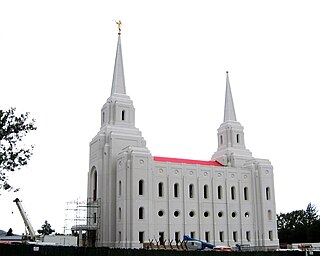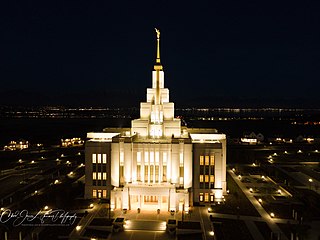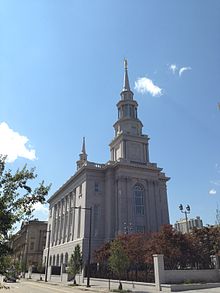
The Oklahoma City Oklahoma Temple is the 95th operating temple of the Church of Jesus Christ of Latter-day Saints. It serves stakes in Oklahoma, Arkansas, and Kansas.

The Draper Utah Temple is the 129th temple of the Church of Jesus Christ of Latter-day Saints. It was dedicated by church president Thomas S. Monson on March 20, 2009, with additional sessions also held through March 22. The intent to build the temple was announced by church president Gordon B. Hinckley on October 2, 2004, during the church's general conference. Prior to the dedication, the temple was open to the public from January 15, 2009 through March 14, 2009.
Below is a chronological list of temples of the Church of Jesus Christ of Latter-day Saints with sortable columns. In the LDS Church, a temple is a building dedicated to be a House of the Lord and considered by church members to be the most sacred structures on earth. Upon completion, temples are usually open to the public for a short period of time, and then each is dedicated as a "House of the Lord," after which only members with a current temple recommend are permitted to enter. Thus, they are not churches or meetinghouses, but rather specialized places of worship. The LDS Church has 367 temples in various phases, which includes 202 dedicated temples, 4 with a dedication scheduled, 48 under construction, 3 with groundbreakings scheduled,, and 110 others announced. Within temples, members of the LDS Church make covenants, receive instructions, and perform rituals and ordinances. Additionally, members consider the temple a place to commune with God, seek God's aid, understand God's will, and receive personal revelation.

The Gilbert Arizona Temple is a temple of the Church of Jesus Christ of Latter-day Saints, located at 3301 South Greenfield Road, at the corner of East Pecos Road in Gilbert, Arizona. The intent to build the temple was announced on April 26, 2008, by church president Thomas S. Monson in a press release. A groundbreaking ceremony, to signify the beginning of construction, was held in 2010. The temple was designed by the architectural firm Architekton. The temple was dedicated in 2014.

The Mexico City Mexico Temple is the 28th constructed and 26th operating temple of the Church of Jesus Christ of Latter-day Saints. The intent to build the temple was announced on April 3, 1967, by church president Spencer W. Kimball.

The Kansas City Missouri Temple is the 137th operating temple of the Church of Jesus Christ of Latter-day Saints. The intent to build the temple was announced on October 4, 2008, by church president Thomas S. Monson during general conference. A groundbreaking ceremony, to signify beginning of construction, was held on May 8, 2010, conducted by Ronald A. Rasband. It is the first to be built in the Kansas City metropolitan area, and the second in Missouri, after the St. Louis Missouri Temple. The temple is 32,000 square feet (3,000 m2) and is on an 8.05 acres (3.26 ha) site.

The Brigham City Utah Temple is a temple of the Church of Jesus Christ of Latter-day Saints in Brigham City, Utah. The intent to build the temple was announced on October 3, 2009, by church president Thomas S. Monson, during general conference. It is the fourteenth temple of the LDS Church completed in Utah.

The Payson Utah Temple is a temple of the Church of Jesus Christ of Latter-day Saints in Payson, Utah. The intent to build the temple was announced in a news release on January 25, 2010, by church president Thomas S. Monson. The temple is located on the southernmost edge of Utah's Wasatch Front, and is the state's 15th temple.

The Indianapolis Indiana Temple is a temple of the Church of Jesus Christ of Latter-day Saints located at the southwest corner of West 116th Street and Spring Mill Road in Carmel, Indiana, north of Indianapolis. The temple was announced on October 2, 2010, by church president Thomas S. Monson. It is the church's first temple in Indiana, and is similar in design to The Gila Valley Arizona Temple, a single-level temple with an end spire and approximately 34,000 square feet..

The Hartford Connecticut Temple is a temple of the Church of Jesus Christ of Latter-day Saints in Farmington, Connecticut. The intent to build the temple was announced on October 2, 2010, by church president Thomas S. Monson, during general conference. It is the church's first in Connecticut and second in New England, following the Boston Massachusetts Temple.

The Provo City Center Temple is a temple of the Church of Jesus Christ of Latter-day Saints, built on the site of the former Provo Tabernacle in Provo, Utah. Completed in 2016, the temple uses much of the external shell of the tabernacle that remained from the original building after a fire in December 2010. The intent to build the temple was announced on October 1, 2011, by church president Thomas S. Monson, during the church's general conference. The temple is the second in Provo, was the sixteenth in Utah, and the church's 150th worldwide. This temple has a distinctive exterior with Gothic-inspired stained glass windows. A groundbreaking ceremony, to signify the beginning of construction, was held on May 12, 2012, conducted by Jeffrey R. Holland.

The Church of Jesus Christ of Latter-day Saints in Pennsylvania refers to the Church of Jesus Christ of Latter-day Saints and its members in Pennsylvania. Joseph and Emma Smith lived in Northern Pennsylvania near the Susquehanna River just prior to the organization of the Church of Christ. Much of the translation of the Book of Mormon and revelation of the priesthood occurred here during that time.

The Church of Jesus Christ of Latter-day Saints has had a presence in the state of Indiana since 1831. The official church membership as a percentage of general population was 0.68% in 2018. According to the 2014 Pew Forum on Religion & Public Life survey, roughly 1% of Hoosiers self-identify themselves most closely with The Church of Jesus Christ of Latter-day Saints. The LDS Church is the 13th largest denomination in Indiana.

The Church of Jesus Christ of Latter-day Saints in New Jersey refers to the Church of Jesus Christ of Latter-day Saints and its members in New Jersey.

The Cedar City Temple is a temple of the Church of Jesus Christ of Latter-day Saints in Cedar City, Utah, United States. The intent to construct the temple was announced by church president Thomas S. Monson on April 6, 2013, during general conference. The temple was announced concurrently with the Rio de Janeiro Brazil Temple. At the time, this brought the total number of temples worldwide to 170. It is the 17th temple built in Utah.

The Tucson Arizona Temple is a temple of the Church of Jesus Christ of Latter-day Saints in Catalina Foothills, Arizona, just north of Tucson. The intent to construct the temple was announced by church president Thomas S. Monson on October 6, 2012, during general conference. The temple is the sixth in Arizona, following those in Mesa, Snowflake, Gila Valley, Gilbert, and Phoenix.

The Saratoga Springs Utah Temple is a temple of the Church of Jesus Christ of Latter-day Saints in Saratoga Springs, Utah. The intent to build the temple was announced on April 2, 2017, by church president Thomas S. Monson, during general conference. The temple is the 18th in Utah and the fifth in Utah County. A groundbreaking ceremony, to signify the beginning of construction, was held on October 19, 2019, conducted by Craig C. Christensen, a church general authority.

The Pocatello Idaho Temple is a temple of the Church of Jesus Christ of Latter-day Saints in Pocatello, Idaho, the sixth in that state. It has a single attached central spire, topped with a statue of the angel Moroni. It was designed by FFKR Architects and church architects Scott Bleak and Joshua Stewart, using streamlined Classical architecture. Construction concluded in 2021, and the temple was dedicated the same year.

The Pittsburgh Pennsylvania Temple is a temple of the Church of Jesus Christ of Latter-day Saints in the Cranberry Township suburb of Pittsburgh. The intent to construct the temple was announced on April 5, 2020, by church president Russell M. Nelson during general conference. The temple is the church's second in the state of Pennsylvania, and the first in the western part of the state.

The Taylorsville Utah Temple is a temple of the Church of Jesus Christ of Latter-day Saints in Taylorsville, Utah. Plans to construct the temple were announced on October 5, 2019 by church president Russell M. Nelson, during the church's general conference. The temple is the first in the city of Taylorsville, the fifth in Salt Lake County, and the twenty-third in the state of Utah.





















